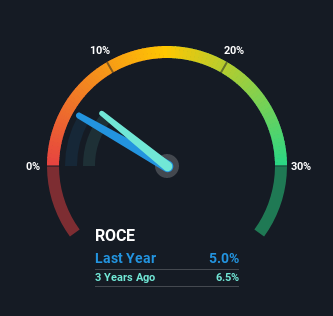- Israel
- /
- Specialty Stores
- /
- TASE:DRAL
Dor Alon Energy In Israel (1988) (TLV:DRAL) Might Be Having Difficulty Using Its Capital Effectively

There are a few key trends to look for if we want to identify the next multi-bagger. Ideally, a business will show two trends; firstly a growing return on capital employed (ROCE) and secondly, an increasing amount of capital employed. Ultimately, this demonstrates that it's a business that is reinvesting profits at increasing rates of return. In light of that, when we looked at Dor Alon Energy In Israel (1988) (TLV:DRAL) and its ROCE trend, we weren't exactly thrilled.
What is Return On Capital Employed (ROCE)?
For those who don't know, ROCE is a measure of a company's yearly pre-tax profit (its return), relative to the capital employed in the business. The formula for this calculation on Dor Alon Energy In Israel (1988) is:
Return on Capital Employed = Earnings Before Interest and Tax (EBIT) ÷ (Total Assets - Current Liabilities)
0.05 = ₪186m ÷ (₪5.6b - ₪1.9b) (Based on the trailing twelve months to September 2021).
Therefore, Dor Alon Energy In Israel (1988) has an ROCE of 5.0%. In absolute terms, that's a low return and it also under-performs the Specialty Retail industry average of 12%.
View our latest analysis for Dor Alon Energy In Israel (1988)

While the past is not representative of the future, it can be helpful to know how a company has performed historically, which is why we have this chart above. If you're interested in investigating Dor Alon Energy In Israel (1988)'s past further, check out this free graph of past earnings, revenue and cash flow.
How Are Returns Trending?
In terms of Dor Alon Energy In Israel (1988)'s historical ROCE movements, the trend isn't fantastic. Around five years ago the returns on capital were 9.3%, but since then they've fallen to 5.0%. However, given capital employed and revenue have both increased it appears that the business is currently pursuing growth, at the consequence of short term returns. And if the increased capital generates additional returns, the business, and thus shareholders, will benefit in the long run.
In Conclusion...
While returns have fallen for Dor Alon Energy In Israel (1988) in recent times, we're encouraged to see that sales are growing and that the business is reinvesting in its operations. And the stock has done incredibly well with a 175% return over the last five years, so long term investors are no doubt ecstatic with that result. So while the underlying trends could already be accounted for by investors, we still think this stock is worth looking into further.
Dor Alon Energy In Israel (1988) does have some risks, we noticed 2 warning signs (and 1 which makes us a bit uncomfortable) we think you should know about.
While Dor Alon Energy In Israel (1988) isn't earning the highest return, check out this free list of companies that are earning high returns on equity with solid balance sheets.
New: Manage All Your Stock Portfolios in One Place
We've created the ultimate portfolio companion for stock investors, and it's free.
• Connect an unlimited number of Portfolios and see your total in one currency
• Be alerted to new Warning Signs or Risks via email or mobile
• Track the Fair Value of your stocks
Have feedback on this article? Concerned about the content? Get in touch with us directly. Alternatively, email editorial-team (at) simplywallst.com.
This article by Simply Wall St is general in nature. We provide commentary based on historical data and analyst forecasts only using an unbiased methodology and our articles are not intended to be financial advice. It does not constitute a recommendation to buy or sell any stock, and does not take account of your objectives, or your financial situation. We aim to bring you long-term focused analysis driven by fundamental data. Note that our analysis may not factor in the latest price-sensitive company announcements or qualitative material. Simply Wall St has no position in any stocks mentioned.
About TASE:DRAL
Dor Alon Energy In Israel (1988)
Develops, constructs, and operates fueling complexes and commercial centers in Israel.
Proven track record and fair value.
Similar Companies
Market Insights
Community Narratives



